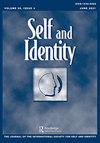Identity development across the transition from primary to secondary school: The role of personality and the social context
IF 2.1
4区 心理学
Q3 PSYCHOLOGY, SOCIAL
引用次数: 0
Abstract
ABSTRACT The secondary school transition may be important for identity change. We investigated identity change and subgroups therein, and whether personal and environmental factors explain subgroup membership. Data was used from four timepoints across the last year of primary and first year of secondary school from 241 adolescents (M age = 11.6, range 10.5–12.8). Identity change was generally in the direction of higher pre-transition commitment and lower post-transition commitment and exploration, with most change as well as differences therein manifesting post-transition. Neuroticism and best friend support did not predict group membership; parental support predicted more adaptive change. These findings suggest educational identity change around the transition and especially during its runup is relatively normative, with strong expectations of how adolescents should change.从小学到中学的身份发展:人格的作用和社会背景
中学过渡可能对身份认同的改变很重要。我们调查了身份变化和其中的亚群,以及个人和环境因素是否可以解释亚群成员身份。数据来自小学最后一年和中学一年级的四个时间点,来自241名青少年(M年龄 = 11.6,范围10.5-12.8)。身份变化通常朝着过渡前承诺较高、过渡后承诺和探索较低的方向发展,其中大多数变化及其差异表现为过渡后。神经质和最好朋友的支持并不能预测小组成员;父母的支持预示着更具适应性的变化。这些发现表明,在过渡时期,尤其是过渡期,教育身份的改变是相对规范的,人们对青少年应该如何改变抱有强烈的期望。
本文章由计算机程序翻译,如有差异,请以英文原文为准。
求助全文
约1分钟内获得全文
求助全文
来源期刊

Self and Identity
PSYCHOLOGY, SOCIAL-
CiteScore
5.10
自引率
5.00%
发文量
26
期刊介绍:
Work on self and identity has a special place in the study of human nature, as self-concerns are arguably at the center of individuals" striving for well-being and for making sense of one"s life. Life goals develop and are influenced by one"s view of what one is like, the way one would ideally like to be (or would like to avoid being), as well as one"s perceptions of what is feasible. Furthermore, conceptions of self and the world affect how one"s progress towards these goals is monitored, evaluated, redirected, re-evaluated, and pursued again. Thus, the “self” as a construct has far-reaching implications for behavior, self-esteem, motivation, experience of emotions and the world more broadly, and hence for interpersonal relationships, society, and culture.
 求助内容:
求助内容: 应助结果提醒方式:
应助结果提醒方式:


